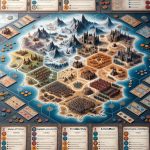House Stark is one of the powerful and iconic houses in the Game of Thrones Board Game, known for its resilient nature and strong sense of honor. In this article, we will delve into the opening strategy for House Stark, focusing on key components that will help players establish a strong foothold in the game.
Understanding the strengths and weaknesses of House Stark is crucial in formulating an effective strategy, as well as forging alliances and utilizing key characters such as Robb Stark.
House Stark’s stronghold in the North gives them a unique advantage, making it essential to secure Winterfell and Moat Cailin early in the game. Additionally, navigating alliances with other houses can significantly impact Stark’s position on the board. The opening strategy also involves effectively utilizing Robb Stark and other family members to gain an edge in battles and negotiations.
As players progress through the game, flexibility and adaptation become vital in adjusting their strategy based on the evolving game board and opponents’ actions. This article will also cover common pitfalls to avoid when playing as House Stark, as well as advanced tactics for late-game dominance. With these strategies in mind, players can enhance their gameplay as House Stark and strive for victory in the Game of Thrones Board Game.
Understanding the Strengths and Weaknesses of House Stark
House Stark is one of the most iconic houses in the Game of Thrones Board Game, known for its resilience, loyalty, and determination. When playing as House Stark, it is important to understand both the strengths and weaknesses of this noble house in order to develop an effective opening strategy.
One of the key strengths of House Stark lies in its control over the North. With strongholds at Winterfell and Moat Cailin, House Stark has a natural advantage in defending its territories and preventing enemy invasions. Additionally, House Stark’s position on the board provides access to valuable resources such as the Shivering Sea and the Bay of Ice, making it a strategic powerhouse in the early game.
However, despite these strengths, House Stark also faces significant weaknesses. The Starks start with fewer units compared to other houses, which can make expansion difficult in the beginning. Furthermore, their isolation in the North can lead to vulnerability if not carefully managed.
When developing an opening strategy for House Stark, players must take into account these strengths and weaknesses to maximize their chances of success. By focusing on securing their home territories and forging alliances with neighboring houses, players can overcome these challenges and establish a strong foundation for future growth.
| Strengths | Weaknesses |
|---|---|
| Control over the North | Start with fewer units |
| Access to valuable resources | Vulnerability due to isolation |
Key Components of the Opening Strategy for Stark
House Stark is a formidable house in the Game of Thrones Board Game, known for its loyalty and strong defensive capabilities. When playing as House Stark, it is crucial to have a clear opening strategy in order to set the tone for the rest of the game. Understanding the key components of the opening strategy for Stark can greatly increase your chances of victory.
One of the most important aspects of the opening strategy for Stark is to secure control over key territories in the North. Winterfell and Moat Cailin are vital strongholds that provide strategic advantages to House Stark. It is imperative to prioritize these territories early in the game, as they offer a defensive advantage and access to valuable supply routes.
Furthermore, forging alliances with other houses can be a significant part of Stark’s opening strategy. While House Stark is known for its independence, forming strategic alliances with other houses can provide crucial support and leverage throughout the game. It is important to carefully navigate these alliances, using them to strengthen your position without becoming overly reliant on others.
In addition, utilizing characters like Robb Stark and other members of the Stark family effectively can greatly influence your opening strategy for success. These characters possess unique abilities that can be pivotal in securing territory and gaining power in the early stages of the game.
| Key Components | Importance |
|---|---|
| Securing Winterfell and Moat Cailin | Provides defensive advantage and supply routes |
| Forging Alliances | Strategic support and leverage throughout the game |
| Utilizing Robb Stark and Stark family members | Pivotal abilities for securing territory and gaining power |
By understanding these key components of an effective opening strategy for House Stark in the Game of Thrones Board Game, players can set themselves up for a strong start and lay the groundwork for future success on their path to victory.
Secure the North
House Stark’s position in the Game of Thrones Board Game is heavily reliant on their ability to secure the North. Controlling Winterfell and Moat Cailin is crucial for establishing a strong foundation for Stark’s opening strategy.
Key components of the opening strategy for Stark to secure the North include:
1. Winterfell: As the seat of House Stark, controlling Winterfell gives players a stronghold in the North, providing valuable resources and bolstering their defense against potential enemies. It is essential to prioritize holding onto Winterfell while simultaneously expanding your influence in neighboring territories.
2. Moat Cailin: This strategic location serves as a chokepoint that can be used to control movement through the neck, effectively limiting access to the North. Securing Moat Cailin is critical in preventing adversaries from encroaching on Stark territory and keeping allies within reach.
3. Establishing Supply Lines: It is vital for Stark players to establish supply lines connecting Winterfell and Moat Cailin with their other territories, ensuring that they can reinforce and support their northern holdings effectively.
By focusing on securing the North and these key locations early in the game, Stark can consolidate their power base and set themselves up for success as the game progresses.
Ultimately, controlling Winterfell and Moat Cailin sets the stage for House Stark to assert their dominance in the North and lay a solid foundation for executing their long-term strategies in the Game of Thrones Board Game.
Forging Alliances
Navigating alliances with other houses is a crucial aspect of playing as House Stark in the Game of Thrones Board Game. While Stark may be one of the more isolated factions on the game board, forging strategic alliances can greatly impact their position and potential for success in the game.
One key aspect of navigating alliances as Stark is to assess the current political landscape of the game board. This involves evaluating which houses are in close proximity to Stark’s territories, as well as understanding each house’s individual strengths and weaknesses. For example, aligning with a house that has a strong naval presence can help Stark defend its northern territories from potential sea invasions.
Additionally, it’s important for Stark players to consider their long-term goals when forming alliances. Whether it’s securing certain strongholds or gaining access to specific resources, aligning with another house should serve a strategic purpose that ultimately benefits the Stark player’s overall position in the game. This can involve negotiating trade agreements, military support, or even joint efforts to confront common enemies.
Ultimately, navigating alliances as House Stark requires careful consideration and diplomatic finesse. It’s important for players to strike a balance between leveraging their own strengths and resources while also capitalizing on the unique advantages that come with forming strategic partnerships with other houses. By doing so, Stark players can significantly bolster their position and increase their chances of emerging victorious in the Game of Thrones Board Game.
Utilizing Robb Stark and the Stark Family Members Effectively
House Stark in the Game of Thrones Board Game is known for its strong family members and notable leader, Robb Stark. Utilizing these characters effectively is crucial for a successful opening strategy as House Stark.
To make the most out of the Stark family members, players should prioritize using them in key battles and influence tracks. Here are some ways to effectively utilize Robb Stark and other Stark family members:
1. Robb Stark: As the eldest son of Eddard Stark, Robb is a formidable leader with strong military capabilities. Players should consider using him to lead armies into battles or to support military challenges. His abilities can also be used to bolster the fighting strength of House Stark’s forces.
2. Sansa Stark: Sansa has a unique ability to secure alliances with other houses through her diplomatic skills. Players should leverage her ability to forge alliances with other players to protect the North and gain support in critical areas.
3. Arya Stark: With her tracking abilities, Arya can be a valuable asset when it comes to gathering intelligence on opponents’ movements and strategies. By placing Arya strategically on the board, players can gain valuable information and plan their moves more effectively.
Utilizing these family members effectively can give House Stark an edge in the early stages of the game, setting them up for success as they navigate the complex political landscape of Westeros.
By prioritizing these characters and their unique abilities, players can solidify House Stark’s position on the board while setting themselves up for success in battles and strategic maneuvering.
Flexibility and Adaptation
House Stark is known for its honor and loyalty, and these qualities are reflected in the Game of Thrones Board Game. However, to be successful as House Stark, players must also exhibit flexibility and adaptability in their opening strategy. This section will delve into the importance of adjusting the initial plan based on the game board and opponents’ actions.
Evaluating the Game Board
When playing as House Stark, one must carefully assess the game board at the beginning of the match. Different regions may present varying opportunities and challenges for Stark. For instance, controlling Winterfell is crucial for Stark’s success, but neighboring regions such as The Twins or Moat Cailin may also require attention. By evaluating the board, players can make informed decisions about where to concentrate their forces and which areas to prioritize in their opening moves.
Assessing Opponents’ Actions
Another aspect of flexibility in playing as House Stark is keeping an eye on opponents’ actions and adjusting accordingly. If a neighboring house is advancing aggressively towards Stark territories, it may be necessary to shift focus from expansion to defense. On the other hand, if an opportunity arises to form alliances or cooperate with other houses against a common rival, players should be ready to adapt their strategy and take advantage of such possibilities.
Remaining Adaptable Throughout the Game
Flexibility doesn’t end with the opening moves; it is an ongoing characteristic that should be maintained throughout the game. As circumstances change and alliances shift, House Stark players must remain adaptable in their decision-making process. Being rigid in strategy can lead to missed opportunities or vulnerability to enemy offensives. Therefore, constant assessment of both the game board and opponents’ actions is essential for success in playing as House Stark.
By understanding the need for flexibility and adaptation in adjusting the opening strategy based on the game board and opponents, players can increase their chances of achieving victory as House Stark in the Game of Thrones Board Game.
Common Pitfalls and How to Avoid Them When Playing as Stark
House Stark, the noble ruling house of the North, has a unique set of strengths and weaknesses in the Game of Thrones Board Game. While they possess formidable defensive capabilities and strong leadership with Robb Stark, they also face challenges such as limited territory and vulnerability to isolation. To ensure a successful game as House Stark, it’s important to understand common pitfalls and how to avoid them.
Overextending Too Early
One common mistake when playing as Stark is overextending too early in the game. The temptation to expand quickly and seize control of neighboring territories can leave Winterfell vulnerable to attack. Instead, focus on securing key strongholds like Winterfell and Moat Cailin before considering aggressive expansion. This will provide a solid base from which you can expand strategically while protecting your core territories.
Failing to Forge Alliances
House Stark’s relative isolation in the North can make it challenging to navigate alliances with other houses. Failing to forge alliances or misreading the intentions of other players can leave Stark isolated and vulnerable to coordinated attacks. It’s crucial for Stark players to assess the political landscape carefully and cultivate alliances that serve their strategic goals without compromising their own position.
Underestimating Late-Game Threats
Finally, a common pitfall for players controlling House Stark is underestimating late-game threats. As the game progresses, powerful enemies may emerge from unexpected quarters or alliances may shift dramatically. To avoid being caught off guard, maintain flexibility in your strategy and keep a close eye on potential threats developing across the board. By staying vigilant and adaptable, you can mitigate this risk and position yourself for success in the latter stages of the game.
By recognizing these common pitfalls and implementing strategies to address them, players controlling House Stark can bolster their chances of victory in the Game of Thrones Board Game. Through careful play, diplomatic finesse, and strategic foresight, even an underdog like House Stark can rise to dominate Westeros.
Advanced Tactics for Late-Game Dominance as House Stark in the Game of Thrones Board Game
In conclusion, mastering the opening strategy for House Stark in the Game of Thrones Board Game is crucial for setting the stage for late-game dominance. Understanding the strengths and weaknesses of House Stark, as well as key components of their opening strategy, is essential for players looking to secure victory.
By focusing on securing the North through controlling Winterfell and Moat Cailin, forging strategic alliances with other houses, effectively utilizing Robb Stark and the Stark family members, and remaining flexible and adaptable, players can set themselves up for success.
One of the most important aspects of the opening strategy for Stark is securing the North. Controlling Winterfell and Moat Cailin not only provides strategic advantages but also strengthens Stark’s position on the game board. Additionally, navigating alliances with other houses can greatly impact Stark’s standing in the game. Whether it’s forming temporary alliances or making diplomatic moves, forging relationships with other players is a crucial part of playing as House Stark.
As players progress through the game, remaining flexible and adaptable becomes increasingly important. Adjusting strategies based on the game board and opponents’ moves can make all the difference in achieving late-game dominance. In addition to avoiding common pitfalls when playing as Stark, mastering advanced tactics for late-game dominance is essential for securing victory in the Game of Thrones Board Game. By implementing these strategies and staying one step ahead of opponents, players can truly dominate as House Stark.
Frequently Asked Questions
How Long Does Game of Thrones Board Game Take?
The length of a Game of Thrones board game session can vary, but typically it can take anywhere from 2 to 4 hours to complete a game. Factors such as the number of players and their familiarity with the game can also impact the duration.
How Does Game of Thrones Board Game Work?
Game of Thrones board game is a strategy board game that involves elements of diplomacy, warfare, and resource management. Players take on the roles of different houses and must use their armies and alliances to conquer territory and achieve objectives in order to win the game.
Is Game of Thrones Board Game Hard to Learn?
Learning how to play Game of Thrones board game may seem challenging at first due to its complexity and strategic depth. However, with patience and practice, the game becomes easier to understand. The rulebook provides clear instructions, and once players become familiar with the mechanics, it becomes an engaging experience.

I love playing all kinds of games – from classics like Monopoly to modern favourites like Ticket to Ride.
I created this blog as a way to share my love of board games with others, and provide information on the latest releases and news in the industry.





